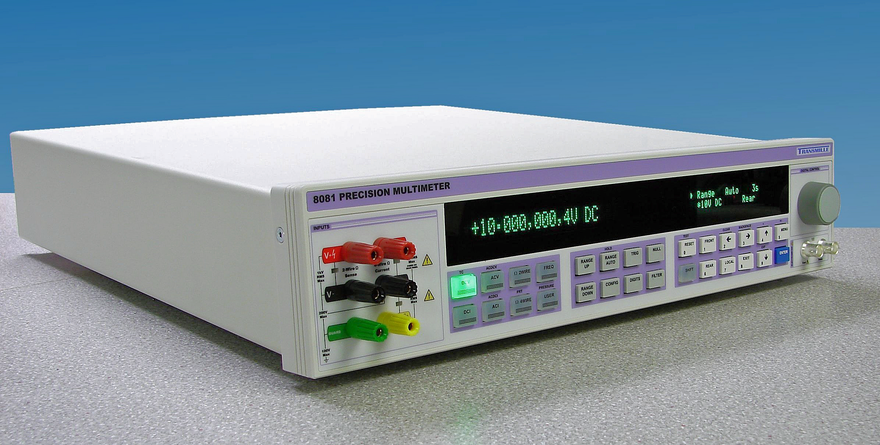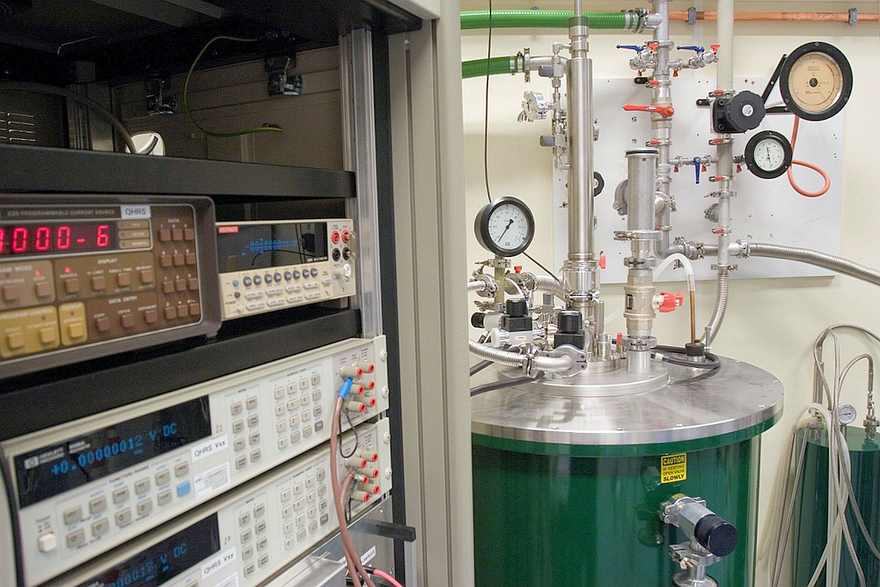Transmille, a leading UK manufacturer of high-accuracy digital multimeters (DMMs), was seeking a resistor component for a new series of 8.5- and 7.5-digit units. To achieve necessary 8.5-digit accuracy, the specified resistor needed to offer extremely low TCR, high-precision, repeatability, low thermal EMF, low noise, long-term stability, and minimal harmonic distortion. As the multimeter was based on analog circuit design, the resistor needed to have minimal drift from initial values when operating above room temperatures. The customer selected a VPG Bulk Metal Foil resistor, due to its low TCR specification of <1 ppm/°C maximum at +20°C. In addition to extremely low TCR, the resistor offered a low PCR of 5 ppm at rated power; load-life stability of ±0.005% at +70 °C for 2000 hours, or ±0.015% for 10,000 hours; a thermal EMF of <0.05 μV/°C; and non-measurable noise.

A Transmille DMM
The extremely low TCR of the Bulk Metal Foil resistor allowed Transmille to introduce a new digital multimeter to market which could offer both industry best-in-class performance and necessary 8.5-digit accuracy. The resistor offered exceptional stability under maximum allowable drift, over thousands of hours of field service, even under harsh conditions. The user was further able to achieve this level of resistor performance rather cost-effectively. This allowed Transmille to introduce a new high-performance digital multimeter to market at a highly competitive price point.
Metrology Secondary Reference
In another example, VSL, the National Metrology Institute (NMI) of the Netherlands, approached VPG for a high-precision resistor solution, as a secondary reference standard in its quantum Hall resistance (QHR) experiments. QHR is the globally recognized primary quantum resistance standard, with values of around 12.9 kΩ and 6.45 kΩ. To serve as an adequate secondary reference standard, VSL needed a cost-effective, high-precision resistor, the values of which needed to closely match those of the primary QHR standard, yet offer a well-defined four-terminal configuration, low noise, low TCR and no RH effect, along with excellent long-term stability.
Based upon the low TCR offered by VPG, VSL selected one of the company’s ultra-high precision resistors. The chosen resistor integrated 11 elements into a single housing, allowing for lower TCR and longer-term drift than could be achieved via a single resistive element. The device offered the necessary terminal connections, hermetic sealing for humidity protection, and oil fill, further ensuring that resistance values would remain largely unaffected by sudden temperature changes. The units were then tested for TCR value confirmations vis-à-vis the published VPG specification. For this purpose, the resistor was subsequently mounted within an enclosure thermostated at 29.00 ± 0.02°C, for further reduction of TCR effects, then measured against the primary QHR over a more than five-year period.
Precision resistors
Results of the five-year study showed that the actual long-term TCR of the two Bulk Metal Foil resistive elements were less than 0.5 ppm/°C over a temperature range of +18 °C to +28 °C, with a (very) small second order temperature coefficient Beta. This was well below the initial published 2 ppm/°C specification (over -55 °C to +125 °C), and proved the VPG resistors to be a reliable secondary QHR reference standard. Here, published TCR served as an added benefit, in terms of its empirically proven capability to exceed published specifications under long-term use


Diode Laser Current Drivers
In another example, low-cost and easy-to-use diode lasers are a virtual measurement staple in experimental atomic physics. For a diode laser to maintain its frequency, output power, current and temperature, careful regulation of parameters is required. To best manage costs, the Physics Department at California State University looked to construct its own low-cost, low-noise current source for use with its in-laboratory diode lasers. To generate a suitably stable laser stream, the current sense resistor needed to be resistant to both internal and external temperature drifts, have a high-power rating, and a low thermal EMF. The most critical element of the current driver is the sub-circuit, responsible for current regulation since laser stability must not exceed overall sense resistor stability. In this application, the use of traditional commercial current controllers was too cost-prohibitive. The viable resistor solution, therefore, needed to be both low-cost and high-precision.
By using a high-precision Bulk Metal Foil resistor with a low TCR of 2 ppm/°C typical (–55°C to +125°C, +25°C ref.), tolerance of 0.01% and a 10 W power rating, the end-user could integrate a regulated voltage within its sub-circuit, and yet still control the amount of current emitted from the laser current driver. The latter was achieved by tuning the driver to a set voltage on an adjustable voltage regulator. This preset total resistance value ensured that the voltage drop was large enough for accurate current regulation, though small enough as not to influence regulated supply voltage. Here, the specific combination of long-term stability and low TCR made the Bulk Metal Foil resistor an optimal solution within a low-cost, high-precision application. The solution proved to be viable, as the user was assured of TCR specification accuracy.
The “True” Value of TCR in High-Precision Resistor Selection
For engineers selecting high-precision resistors, TCR specifications can help them to better predict reversible shifts in component resistance from an ohmic value within the application, both under intended operating temperatures and within the installation environment. Such data offer insights into key longer-term resistor performance indicators and ultimately finished product designs. As TCR calculation methods can vary by manufacturer, manufacturing process, materials of construction, and other aspects, it is important for an end-user to understand any nuances in the chosen method. This understanding, in turn, helps them to better understand the value of such data as a true component reliability metric. VPG Foil Resistor methods for TCR calculation follow strict protocols for high-precision resistors, with the goal of helping customers to be confident in the long-term reliability of such components within demanding applications. For more information regarding TCR and the Bulk Metal Foil portfolio of VPG Foil Resistors, visit www.vpgfoilresistors.com.
About the authors
- Reuven Goldstein is the director of engineering and R&D for the Vishay Foil Resistors brand of Vishay Precision Group, Inc., a position in which he has served since the company’s formation in 1997. In this role, he is responsible for the worldwide R&D of all foil resistor products, while overseeing all process and equipment engineering functions of the company’s facilities in Israel, Japan and Germany. Based in Holon, Israel, Mr. Goldstein is a 44-year expert in resistive foil sensing technology.
- Molly Bakewell Chamberlin is the president of the Buffalo, New York-based, Embassy Global, LLC, now celebrating its tenth year as a 100% woman-owned integrated technical marketing, PR and business development firm. The firm helps to guide the strategic sales and marketing direction of many of the industry’s leading B2B manufacturers of sensors, instrumentation, data acquisition, electronic components, motion control products, and software. Ms. Chamberlin is a longtime recognized global subject matter expert in sensors and instrumentation. She is also a mentor and coach to tech startups and serves as an expert advisor for various M&A and private equity firms on non-confidential aspects of the industry.
